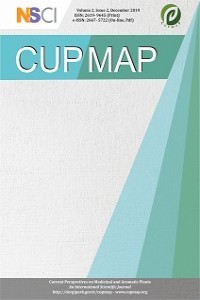The Effect of Corchorus olitorius L. Extract on Viability of Breast Cancer Cells: A friend or a foe?
The Effect of Corchorus olitorius L. Extract on Viability of Breast Cancer Cells: A friend or a foe?
Corchorus olitorius, MCF-7, Breast cancer, Cell viability,
___
- 1. Adegoke, A.A., Adeboye-Tayo, B.C., 2009. Phytochemical composition and antimicrobial effects of Corchorous olitorius leaf extracts on four bacterial isolates. Journal of Medicinal Plants Research, 3(3), 155-159.
- 2. Azuma, K., Nakayama, M., Koshioka, M., Ippoushi, K., Yamaguchi, Y., Kohata, K. et al., 1999. Phenolic Antioxidants from the Leaves of Corchorus olitorius L. Journal of Agricultural and Food Chemistry, 47, 10, 3963-3966. DOI 10.1021/jf990347p
- 3. Becer, E., Soykut, G., Kabadayı, H., Mammadov, E., Çalış, İ., Vatansever, S. 2020. Obtaining Stem Cell Spheroids from Foreskin Tissue and the Effect of Corchorus olitorius L. on Spheroid Proliferation. Turkish Journal of Phamaceutical Sciences. DOI: 10.4274/tjps.galenos.2019.05658 [article ahead of printing]
- 4. Bhagwat, S., Haytowitz, D.B., Holden J.M. 2011. USDA Database for the Flavonoid Content of Selected Foods (Report No: 3). Beltsville Human Nutrition Research Center: United States Department of Agriculture.
- 5. Boye, A., Barku, V.Y.A., Amoateng, P., Mbroh, L.A. 2014. Anti-nociceptive and antioxidant activities of an aqueous leaf extract of Corchorus olitorius L. (Tiliaceae). International Journal of Biological and Chemical Sciences, 8(6), 2395-2406. DOI 10.4314/ijbcs.v8i6.3
- 6. Dewanjee, S., Sahu, R., Karmakar, S. Gangopadhyay, M., 2013. Toxic effects of lead exposure in Wistar rats: Involvement of oxidative stress and the beneficial role of edible jute (Corchorus olitorius) leaves. Food Chemical Toxicology, 55, 78-91. DOI 10.1016/j.fct.2012.12.040
- 7. Duke, J.A. 1983 Handbook of Energy Crops; Corchorus olitorus L. Accessed online at 23.11.2015 https://hort.purdue.edu/newcrop/duke_energy/Corchorus_olitorius.html
- 8. Handoussa, H., Hanafi, R., Eddiasty, I., El-Gendy, M., El-Khatip, A., Linscheid, M. et al. 2013. Anti-inflammatory and cytotoxic activities of dietary phenolics isolated from Corchorus olitorius and Vitis vinifera. Journal of Functional Foods, 5, 1204-1216. DOI 10.1016/j.jff.2013.04.003
- 9. İşeri, Ö.D., Yurtcu, E., Sahin, F.İ., Mehmet, H., 2013. Corchorus olitorius (jute) extract induced cytotoxicity and genotoxicity on human multiple myeloma cells (ARH-77). Pharmaceutical Biology, 51(6), 766-770. DOI 10.3109/13880209.2013.765897
- 10. Kasiri, N., Rahmati, M., Ahmedi, L., Eskandari, N., Motedayyen, H. 2019. Therapeutic potential of quercetin on human breast cancer in different dimensions. Inflammopharmacology. DOI 10.1007/s10787-019-00660-y. [Epub ahead of print]
- 11. Li, G.J., Huang, S.Y., Wu, M.Y., Chen, Y.C., Tsang, S.F., Chyuan, J.H., et al. 2012. Induction of Apoptosis by Ethanolic Extract of Corchorus olitorius Leaf in Human Hepatocellular Carcinoma (HepG2) Cells via a Mitochondria-Dependent Pathway. Molecules, 17, 9348-9360. DOI 10.3390/molecules17089348.
- 12. Maggiolini, M., Bonofiglio, D., Marsico, S., Panno, M.L., Bruno Cenni, B., Picard, D., And`O, S., 2001. Estrogen Receptor α Mediates the Proliferative but Not the Cytotoxic Dose-Dependent Effects of Two Major Phytoestrogens on Human Breast Cancer Cells. Molecular Pharmacology, 60(3), 595-602.
- 13. Miodini, P., Fioravanti L., Di Fronzo G., Cappelletti V., 1999. The two phyto-oestrogens genistein and quercetin exert different effects on oestrogen receptor function. British Journal of Cancer, 80(8), 1150-1155. DOI 10.1038/sj.bjc.6690479
- 14. Pal, D.K., Mandal, M., Senthilkumar, G.P., Padhiari, A, 2006. Antibacterial activity of Cuscuta reflexa stem and Corchorus olitorius seed. Fitoterapia, 77, 589-591. DOI 10.1016/j.fitote.2006.06.015
- 15. Singh, B., Mense, S.M., Bhat, N.K., Putty, S., Guthiel, W.A., Remotti, F., Bhat, H.K., 2010. Dietary Quercetin Exacerbates the Development of Estrogen-Induced Breast Tumors in Female ACI Rats. Toxicology and Applied Pharmacology, 247(2), 83–90. DOI 10.1016/j.taap.2010.06.011
- 16. Soykut, G., Becer, E., Calis, I., Yucecan, S., Vatansever, S. 2018. Apoptotic effects of Corchorus olitorius L. leaf extracts in colon adenocarcinoma cell lines. Progress in Nutrition, 20, 4, 689-698. DOI 0.23751/pn.v20i4.6892
- 17. Sørensen, B.G., 2018. Quercetin - creating an estrogenic response. University of Copenhagen. Accessed online at 27.11.2019 https://natoxaq.ku.dk/toxin-of-the-week/quercetin/
- 18. Türkomp. 2018. Ulusal Gıda Kompozisyon Veri Tabanı, C Vitamini. Accesed online at 17.06.2018. http://www.turkomp.gov.tr/component_result-c-vitamini-32
- 19. WCRF, World Cancer Research Fund/American Institute for Cancer Research (2018). Diet, Nutrition, Physical Activity and Breast Cancer: A Global Perspective (Report No: 2018 revised). Dietandcancerreport.org: World Cancer Research Fund/American Institute for Cancer Research.
- 20. WHO World Health Organization. 2019. Breast Globacan 2018. Accessed online at 27.11.2019 https://gco.iarc.fr/today/data/factsheets/cancers/20-Breast-fact-sheet.pdf
- 21. Wu, Q., Needs, P.W., Lu, Y., Kroon, P.A., Daoyuan Rena, D., Yang, X., 2018. Different antitumor effects of quercetin, quercetin-3’-sulfate and quercetin-3-glucuronide in human breast cancer MCF-7 cells. Food & Function, 9, 1736–1746. DOI 10.1039/c7fo01964e
- ISSN: 2619-9645
- Yayın Aralığı: Yılda 2 Sayı
- Başlangıç: 2018
- Yayıncı: Nazım ŞEKEROĞLU
Hanife ARDAHANLI, Süleyman GÜL
Višnja OREŠČANİN, štefica FİNDRİ GUSTEK, İvan FİSTONİC, Damir HODZİC, Josip VALETİC, Josipa RODİC
Olcay ARABACI, Çiğdem SÖNMEZ, Amir Hasan TAGHİLOOFAR, Uğur TAN, Emine BAYRAM
Bekir TOSUN, Tahsin KARADOĞAN, Arif ŞANLI
Olcay ARABACI, Uğur TAN, Hafize SERT, Burak BAYKAL, Mukaddes TOPÇU, Mestan YUSMAK
The Efficiency of Bioapifit® Wound Care Ointment in the Treatment of Diabetic Foot Ulcers
Višnja OREŠČANİN, Zrinka MİHALİC, Josipa RODİC, štefica FİNDRİ GUSTEK
Slovak Chamomile Varieties and their Comparison of Natural Components
Researches on Cultivation of Medicinal and Aromatic Plants in Kayseri
Ahmet YENİKALAYCI, Kemal GÜL, Mahmut GÜNEŞ
Abubker O. BABİKER, Areeg A. ABDELWAKEEL, İbrahim F. AHMED, Ahmed ELSHİKH
The Effect of Corchorus olitorius L. Extract on Viability of Breast Cancer Cells: A friend or a foe?
Günsu SOYKUT ÇAĞSIN, Eda BECER, İhsan ÇALIŞ, Seda VATANSEVER
